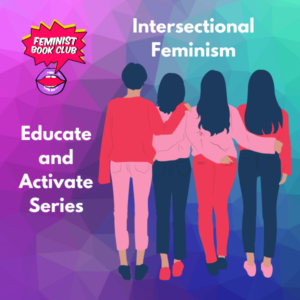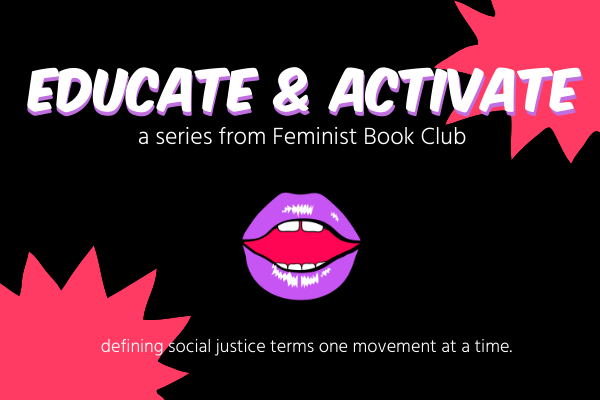Feminist Book Club blog contributors are working together to create posts as an “Educate & Activate” series. We will define a term or movement, provide historical context, and give you additional resources to learn more. We believe that an educated populace can be better activists, accomplices and co-conspirators. It is important to note that these are meant to be brief descriptions and not inclusive or exhaustive of all resources. We urge you to continue being curious, and continue learning more.
 Definition
Definition
What is Intersectional Feminism? Broadly, intersectionality is defined as “the complex, cumulative manner in which the effects of different forms of discrimination combine, overlap, or intersect.” It is now used to “illustrate the interplay between any kinds of discrimination, whether it’s based on gender, race, age, class, socioeconomic status, physical or mental ability, gender or sexual identity, religion, or ethnicity.”
First usage
First known usage of intersectional feminism was in 1989 by scholar and civil rights advocate, Kimberlé Crenshaw. Even though she coined the term, Crenshaw has cited 19th century Black Liberation activist Anna J. Cooper to Angela Davis as articulating its true meaning.
Historical context
Intersectional feminism analyzes how different factors like race, class, sexuality, ableism, and immigration need to be considered truly discuss feminism. Crenshaw’s article, “Mapping the Margins” argues how who are “both women and people of color” are marginalized by issues of both racism and sexism. Non-white women are marginalized by discourses of both race and sex. Crenshaw also identifies three facets that affect the visibility of non-white women:
- + structural intersectionality – how non-white women experience domestic violence and rape
- + political intersectionality – how laws and policies that decrease the visibility of violence against non-white women
- + representational intersectionality – how representations in pop culture are inauthentic in comparison to the real experiences of non-white women
Although Crenshaw coined the term, the ideas are also found in Sojourner Truth’s 1851 “Ain’t I a Woman?” speech, writer and civil rights activist Audre Lorde’s works, Cherríe Moraga and Gloria Anzaldúa’s 1981 work This Bridge Called My Back, and author and social activist bell hooks’ 1981 book Ain’t I A Woman, among others.
Intersectional feminism has also expanded by Chandra Mohanty, to include the various contexts of oppression of women globally and by Shelly Grabe who created the term “transnational intersectionality” to signify other factors like economic exploitation, ethnicity, and other social hierarchies.
English comedian Ava Vidal notes, “feminism which is overly white, middle class, cis-gendered and able-bodied represents … doesn’t reflect on the experiences of all the multi-layered facets in life that women of all backgrounds face.” She argues that intersectional feminism must “start listening to and including various groups of women, and their multi-layered facets and experiences of life, and respect them, in the overall debate.”
Intersectionality received widespread attention partly due to the 2017 women’s march in Washington, protesting against the election of Donald Trump as President of the US.
Resources For Further Education
Hood Feminism by Mikki Kendall
Sister Outsider by Audre Lorde
Living a Feminist Life by Sara Ahmed
Women, Race, and Class by Angela Y. Davis
Can We All Be Feminists? edited by June Eric-Udorie
On Intersectionality by Kimberlé Crenshaw (preorder)
Kimberlé Crenshaw’s TED talk “The Urgency of Intersectionality”



Pingback: Educate & Activate The 19th Amendment: History’s Most Exclusive Sorority | Feminist Book Club
Pingback: What to Do for Women's History Month 2021 - She+ Geeks Out
Pingback: Book Review: Becoming Heroines by Elizabeth C. McLaughlin - Feminist Book Club